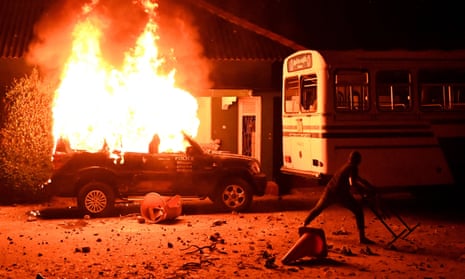Nearly 50 people were injured after authorities used teargas and water cannon to drive back a crowd that stormed the home of Sri Lankan president Gotabaya Rajapaksa, amid anger over the government’s handling of the nation’s deepening economic crisis.
The crisis, the worst in living memory, has caused massive discontent, with people unable to find gas for cooking, medicines, fuel and basic items of food such as milk powder because the country has run out of foreign currency to pay for imported goods.
A crowd of hundreds of people chanted for Rajapaksa and the entire cabinet to resign over his handling of the crisis. Videos circulating on social media showed the protesters shouting “lunatic go home”.
The Rajapaksa family rule the island. The finance minister, prime minister and agriculture minister are the president’s brothers. His nephew is sports minister.
The security forces fired teargas and water cannon to disperse the crowd. Near the presidents’ home in Mirihana, the demonstrators set fire to an army bus and police vehicle.
The violence prompted an overnight curfew, which was lifted on Friday, and the arrests of 45 people. Nearly 50 people, including some journalists, were injured and taken to hospital.
Official sources told AFP that Rajapaksa was not at home during the protest, which was the first to target the president after diesel shortages had sparked demonstrations elsewhere on the island.
The economic meltdown has left the city’s roads eerily empty as fuel pumps run dry. If residents can find petrol, the price has risen from 128 rupees a litre to 300 rupees.

With no air conditioners or fans, people are sweltering during the 10-12 hour power cuts. The government does not have the money to pay for the fuel needed by the power plants.
People with serious medical conditions are struggling to find medicines and hospitals have cancelled operations as they have no diesel to operate the generators that act as back-up during blackouts.
To save electricity, the government has switched off street lighting. Mobile phones have been affected because the standby generators used at the phone base stations have run out of diesel.
“We make sure we charge our phones during the hours we have electricity but the internet is very patchy because the towers aren’t working properly. Supermarkets are shut as they have no electricity for lighting or the freezer compartments and we are paying two to three times the normal price for basic food items,” tourism official Zainoor Adnan told the Guardian before the WhatsApp connection failed.
The government’s decision to plunge into organic farming last year turned out to be disastrous. The ban on all chemical fertilisers, without preparing farmers, led to a surge in prices and food shortages. Although the policy was partially reversed later, the damage had been done.
“Agriculture is seriously distressed. Now they want to import fertilisers but with the war in Ukraine, fertiliser isn’t available because other countries have long-term contracts that have tied up supplies,” said retired Indian diplomat Neelam Deo.
This year, Sri Lanka has to repay $7bn in foreign debt even though it does not have the foreign exchange to import milk powder. Of this debt, about 10% is owed to China.
India has recently extended a $912m loan along with another US$1bn line of credit for Sri Lanka to purchase food and fuel. Sri Lanka is also seeking more loans from China. The government has said it is seeking a bailout from the International Monetary Fund.
Civil society groups have called for another demonstration on Sunday morning and members of the opposition parties are expected to participate.
